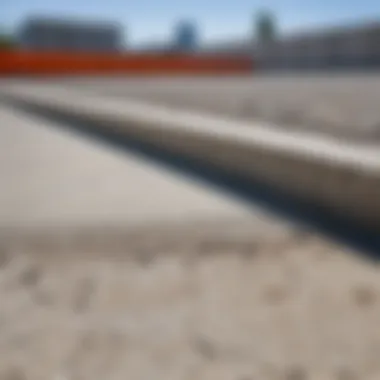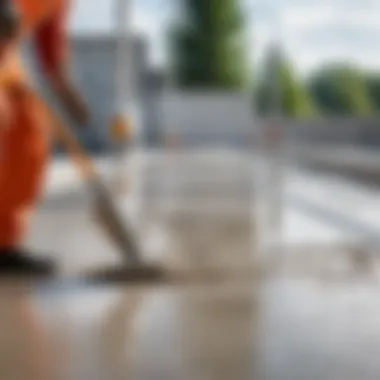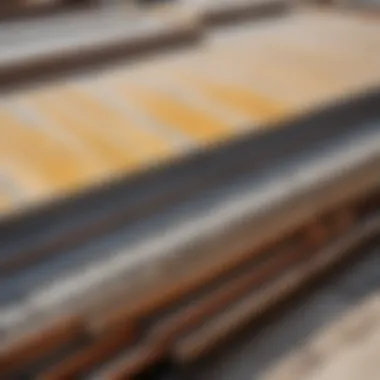Concrete Curing Times and Formwork Removal Explained


Intro
Concrete is a foundational element in construction, and understanding its curing process is essential for anyone involved in building. Curing not only impacts the strength and durability of concrete, but it also has implications for project timelines and effectiveness. This knowledge is useful for both professionals and DIY enthusiasts. In this article, we will delve into the aspects of concrete curing times, the significance of formwork removal, and how these factors play a critical role in various projects.
We will explore the science underlying concrete setting, examine the various factors that influence curing duration, and discuss techniques that can expedite the curing process. Furthermore, we will highlight best practices for efficient formwork removal, ensuring that the structural integrity of the project is maintained while optimizing workflow.
Understanding these elements can enhance the quality of work while minimizing potential issues that may arise during the curing and removal phases.
Проектирование и планирование
Proper project planning is crucial for successful concrete work. This section will discuss effective strategies for selecting a suitable project and evaluating time and resource requirements.
Как выбрать проект для DIY
Choosing the right project is instrumental in achieving desired results. Start by assessing your skills and the complexity of the desired outcome. Beginners may consider simple tasks, such as pouring a small slab or creating decorative features. More advanced projects may involve larger structures, such as patios or foundation work.
Consider the following when selecting a project:
- Purpose of the project (e.g., aesthetics, functionality)
- Available resources and tools
- Required skills and knowledge
- Time frame for completion
Оценка времени и ресурсов
Once the project is chosen, it's vital to estimate the time and resources needed. Take into account:
- The curing time for the specific concrete mix used
- Weather conditions that may prolong curing
- Availability of labor and materials
- Potential delays or complications
Creating a timeline can help manage expectations and guide progress. It ensures that the necessary steps are followed sequentially, from preparation to completion.
Выбор материалов
Selecting the appropriate materials is essential for ensuring a successful concrete project. This section outlines the different types of materials and offers practical purchasing tips.
Типы материалов для различных проектов
Concrete projects often require various materials, which can include:
- Cement: The binding ingredient in concrete, available in multiple types suitable for different applications.
- Aggregates: Graded materials, such as gravel or sand, that provide bulk and strength to the concrete mix.
- Additives: Chemical substances that enhance specific properties of concrete, including curing accelerators or retarders.
Understanding the characteristics of these materials allows for better decision-making regarding their use in different types of projects.
Советы по покупке и экономии
When purchasing materials, consider the following strategies to save costs without compromising quality:
- Compare prices from different suppliers.
- Buy in bulk when possible to reduce per-unit cost.
- Seek recommendations for reliable brands and products.
- Consider purchasing leftover materials from other projects to cut down expenses.
Investing in quality materials is crucial. Poor-quality ingredients can jeopardize the integrity of the concrete and lead to costly repairs.
"A well-planned project leads to smoother execution and better results."
By understanding the curing times of concrete and the necessary steps for effective formwork removal, one can achieve superior results in any construction endeavor. The following sections will delve deeper into the science of curing, best practices for formwork removal, and more insightful tips for both professionals and construction hobbyists.
Understanding Concrete Curing
Concrete curing is a fundamental process in construction, vital for ensuring the longevity and durability of concrete structures. It fundamentally refers to the methods and techniques used to maintain adequate moisture, temperature, and time needed for the concrete to achieve desired strength and durability. Understanding concrete curing helps professionals and DIY enthusiasts alike appreciate the integrity of projects, which avoids future problems such as cracking or structural failures.
Effective curing enhances concrete's resistance to weather conditions, improves surface quality, and ultimately extends the lifespan of structures. This section lays the groundwork for comprehending the concepts surrounding curing, emphasizing its critical role in construction success.
What is Concrete Curing?
Concrete curing is the process of managing moisture and temperature during the hardening phase of concrete. After the concrete is poured, it begins to set, undergoing various chemical reactions that contribute to its strength and structural integrity. Curing usually starts immediately after finishing work is done on the concrete surface.
There are different methods of curing including:
- Water curing: This is the most common method where water is applied directly to the surface.
- Moisture-retaining covers: Covers like wet burlap or plastic sheets can protect the surface from drying out.
- Chemical curing compounds: These products form a membrane that helps retain moisture for a longer time.
Each method has its advantages and appropriate contexts for use. For example, water curing is highly effective for large slabs, whereas chemical solutions may be more efficient for intricate shapes and sizes.


Importance of Curing in Construction
Curing is not an optional step; it is necessary for several reasons. First, curing significantly impacts the strength and durability of the concrete. Properly cured concrete reaches its design strength more effectively than inadequately cured concrete. This translates into less likelihood of cracking or surface defects.
Moreover, curing helps minimize the risk of plastic shrinkage cracks that can occur shortly after pouring, especially in hot weather or with rapid evaporation. Additional factors to consider regarding importance includes:
- Resistance to environmental effects: Curing strengthens the concrete, making it more resistant to harmful external factors such as freeze-thaw cycles.
- Cost-effectiveness: Investing time into proper curing can prevent costly repairs or replacements in the future.
In essence, ensuring proper curing leads to better-performing concrete and ultimately supports the longevity and safety of structures.
Factors Affecting Curing Times
Understanding the factors that affect curing times is paramount for ensuring the structural integrity and longevity of concrete. Proper curing not only enhances strength but also minimizes the risks of cracking and shrinkage. Here we will explore the elements that are critical in determining how long concrete should be cured before it can be used effectively. Each factor serves a unique purpose and offers its own benefits, which underscores the complexity of the curing process.
Type of Concrete Mix
The type of concrete mix significantly influences curing times. Different mixes vary in their composition, which impacts their hydration and setting characteristics. For example, high-performance concrete typically sets faster than traditional mixes, while mixes with high water content can require longer curing times to achieve optimal strength. In addition, the inclusion of additives such as retarders or accelerators can modify curing behavior. Retarders slow down the setting time, making them useful in hot environments, while accelerators do the opposite. They can be important when expedited construction schedules are a priority. Therefore, carefully selecting the appropriate concrete mix for the specific job is essential for planning curing timelines effectively.
Environmental Conditions
Environmental conditions play a crucial role in curing times. Factors such as temperature, wind speed, and sunlight exposure directly affect the rate of moisture loss. Hot and dry weather can lead to rapid evaporation, which risks inadequate curing. Cold weather, conversely, can slow down the hydration process, resulting in extended curing durations. To counteract these effects, it is crucial to monitor local weather conditions and adapt curing methods accordingly. For instance, using insulated blankets or wet coverings can help mitigate extremes, ensuring the concrete remains at an optimal condition for curing.
Humidity and Temperature Effects
Humidity and temperature are closely intertwined when it comes to curing concrete. High humidity levels can provide beneficial moisture, enhancing the curing process. However, excessively humid conditions may lead to problems like efflorescence, which can adversely affect the final finish of the concrete. On the other hand, low humidity coupled with high temperatures leads to swift evaporation of water. This scenario demands urgent attention, as it can fracture the surface and compromise structural quality. Moreover, temperature impact cannot be overstated. Each 10-degree Celsius increase in temperature can double the rate of hydration, thus accelerating setting times. Careful monitoring of these variables during the curing period is essential for achieving desired results.
Proper understanding and management of environmental conditions will lead to better concrete performance and durability, ensuring a longer lifespan for structures.
General Concrete Curing Times
Concrete curing is a critical aspect of the construction process that affects the durability and strength of the material. Understanding general concrete curing times is essential for both professionals and DIY enthusiasts involved in construction projects. It serves as a guideline to ensure optimal properties are achieved in the cured concrete.
Curing times vary significantly based on several factors, making it crucial to have this knowledge to correctly plan and execute projects. Proper curing leads to better strength development, minimizing the risk of cracking and ensuring the longevity of the concrete structures. Knowing when to safely remove formwork is equally important to avoid compromising the integrity of the finished work.
Standard Curing Times for Different Types of Concrete
The standard curing times for concrete can differ based on the type of mix being used. For instance, conventional concrete typically requires approximately 28 days to reach full strength under ideal conditions. However, higher performance mix designs, like high-strength concrete, may require up to 56 days for complete curing, depending on specific formulations.
Here are some general timelines for various concrete types:
- Standard Concrete: 28 days for full strength.
- High-Strength Concrete: 28 to 56 days, depending on the mix.
- Rapid-Setting Concrete: 7 days for initial setting but still continues to cure over several weeks.
Awareness of these timelines is essential when scheduling inspections and planning subsequent construction activities. It ensures that each phase can proceed without delay, which is important for project efficiency.
Short-Term vs Long-Term Curing
Curing can be categorized into short-term and long-term, and understanding the difference is vital. Short-term curing generally refers to the initial phase immediately after concrete placement. This period usually covers the first 7 days, where moisture retention is critical to promote hydration in the concrete. During this time, developers might employ wet burlap or curing compounds.
Long-term curing extends beyond the initial days and is crucial for overcoming any ongoing hydration requirements. This phase could last several weeks depending on environmental conditions. It's during this period that the concrete continues to gain strength beyond initial setting.
Situational Considerations
Different construction sites present unique challenges impacting curing. Ambient temperature is a primary factor; warmer conditions may accelerate curing, requiring more frequent watering to maintain moisture. Conversely, cooler temperatures can prolong curing times, potentially requiring specialized heating or insulation methods.
Other situational factors to consider include:
- Wind and Sun Exposure: Both can lead to moisture evaporation, necessitating additional curing measures.
- Type and Size of the Pour: Larger volumes may require longer curing times due to the mass effect, where the center takes longer to cure than the outer layer.
- Presence of Additives: Certain admixtures can alter the curing duration. For instance, retarders can extend the curing time while accelerators can shorten it.
Recognizing these situational considerations will help in determining the appropriate curing strategy and timelines for your projects, ensuring the best possible outcome.
Methods to Accelerate Curing
Accelerating the curing process of concrete can significantly impact the performance and longevity of structures. Curing is essential for achieving desired strength, durability, and integrity in concrete. Various methods exist to speed up this process, each with its own set of benefits and considerations. Understanding these methods is critical for builders and concrete professionals who aim to optimize their projects and reduce construction time.
Chemical Accelerators
Chemical accelerators are additives that reduce the setting time of concrete. They are particularly useful in cold weather conditions where the natural curing process is slowed. The use of products like calcium chloride is common, but there are other non-chloride options available as well. These accelerators help to maintain productivity on construction sites, allowing for quicker turnovers and efficient project management.
However, while chemical accelerators can be beneficial, they should be used with caution. Improper dosages can lead to undesired effects such as efflorescence or shrinkage. Therefore, it is crucial to follow manufacturer guidelines closely. Understanding the specific requirements for each type of accelerator helps to ensure optimal results, preventing issues that could arise during or after the curing process.


Temperature Management Techniques
Temperature management is another effective method to accelerate curing times. Concrete sets faster in warmer conditions. Thus, controlling the temperature of the mix before and during the curing phase is important. Techniques such as heating the mixing water or using heated enclosures can contribute to maintaining an ideal temperature range for the curing process.
On the other hand, it’s essential to be mindful of excessive heat. If the temperature is too high, it can lead to thermal cracking. Monitoring the concrete temperature is crucial; tools like infrared thermometers can help.
In addition, using insulating blankets or placing concrete in sheltered areas can also protect it from cold drafts, especially during night hours.
Factors such as climate, construction timelines, and desired outcomes should all guide the choice of methods to accelerate curing.
Key Point: Balancing speed with quality is paramount; therefore, understanding the nuances of both chemical accelerators and temperature management techniques is critical to successful concrete curing.
Formwork and Its Role in Curing
Formwork plays a crucial role in the process of curing concrete. It is not just a supporting structure but an integral part of how concrete stabilizes and gains strength. Proper formwork ensures that the concrete has the right environment to cure adequately, preventing premature removal that could lead to structural failure. The design and material of formwork can significantly affect the curing process, impacting the final quality of the concrete.
Types of Formwork Used in Concrete Projects
There are several types of formwork that are commonly used in concrete projects. Each has its own advantages and considerations:
- Timber Formwork: This is the traditional type that is often used for small projects. It is easy to manipulate and provides a good finish. However, it is less durable and may warp over time.
- Steel Formwork: Steel is more durable and offers a smooth finish, making it suitable for larger projects. It is reusable, which can reduce costs in the long run, but it is heavier and requires more handling equipment.
- Aluminum Formwork: This type is lightweight and offers similar advantages as steel. It is often used for high-rise buildings because it allows for quick assembly and disassembly.
- Plastic Formwork: This newer type is gaining popularity for its lightweight and reusable nature. It is often used for complicated shapes and is particularly favored by DIY enthusiasts for small projects.
- Permanent Formwork: This is integrated into the structure, providing insulation or soundproofing. It eliminates the need for removal but adds to the initial construction costs.
Understanding these options helps in selecting the best formwork for specific projects, enhancing the curing process.
Importance of Proper Formwork Design
The design of formwork is vital to the success of any concrete project. Properly designed formwork should:
- Ensure the concrete maintains shape during curing.
- Protect the concrete from environmental factors, such as direct sunlight or rain.
- Be easily removable without damaging the cured concrete.
- Allow for the efficient flow of unearthed water, preventing pooling that can weaken the structure.
A well-constructed formwork also enables uniform curing by keeping the concrete at optimal moisture levels. Uneven or poorly designed forms can lead to weaknesses in the finished product. This is particularly critical in structural applications where any deficiency can have serious consequences.
In essence, the formwork's role extends beyond mere support. It actively shapes the quality and durability of the concrete, establishing a foundation for successful construction outcomes.
Proper formwork design is essential for achieving both structural integrity and longevity in concrete projects.
Timing for Formwork Removal
The timing for formwork removal is crucial in concrete construction. It plays a significant role in ensuring the structural integrity and longevity of the finished project. Proper timing not only affects the quality of the concrete but also influences the overall efficiency of the construction process. Understanding when to remove the formwork is essential for avoiding premature removal, which can lead to defects and other issues.
It is important to consider several factors when determining the correct timing for formwork removal. These factors include the type of concrete mix used, environmental conditions, and specific project demands. When done correctly, the removal of formwork can contribute significantly to the success of the construction project, ensuring that it meets both safety standards and aesthetic expectations.
Recommended Time Frames for Removal
Recommended time frames for formwork removal vary based on concrete strength achieved and environmental conditions. Generally, for vertical formwork, it is advisable to remove the forms after 24 to 48 hours. For horizontal surfaces, such as slabs, a period of 7 to 14 days is often recommended.
This timeline can shift according to the specific concrete mix. For example, high-strength concrete may require a longer curing time. Additionally, cold weather will slow down the curing process, extending the time before formwork can be safely removed.
To optimize the results, adhering to the following guidelines is beneficial:
- 24-48 hours for vertical slabs.
- 7-14 days for horizontal members.
- Consider higher durations in colder climates.
- Always refer to manufacturers’ specifications for unique mixes.
Signs of Adequate Curing Prior to Removal
It is essential to check for signs of adequate curing before removing formwork. Rushing this process can result in damage to the concrete or lower strength than desired. Several indicators signal that the concrete is ready for formwork removal:
- Firm Surface: The surface should feel solid to touch without any soft areas or deformities.
- Color Change: A noticeable change in color often indicates sufficient hydration and curing.
- Moisture Content: The concrete should retain some moisture but not excessively wet.
- Strength Testing: Conducting a compressive strength test can provide definitive data on the concrete's readiness.
"The integrity of concrete construction relies heavily on the timing and care taken during formwork removal."
Proper attention to these signs can prevent structural issues in the future, such as cracks or weak spots.
Best Practices for Formwork Removal
Formwork removal is a crucial step in concrete construction. Following best practices can ensure the integrity of the concrete and the safety of workers. Proper techniques and considerations can greatly enhance the quality of the finished structure. Understanding the various aspects involved in formwork removal is essential for achieving a successful outcome.
Techniques for Safe Removal


Safe removal of formwork starts with proper planning. It is essential to assess the curing state of the concrete before beginning. A few techniques should be followed:
- Timing: Wait until the concrete has gained sufficient strength. Typically, the recommended time frames might vary based on factors like type of concrete and environmental conditions.
- Careful Unfastening: Use hand tools, such as pry bars and hammers, to gently loosen the formwork. Avoid using excessive force, which may damage the edges of the concrete.
- Sequential Removal: Start with the side forms before tackling the bottom. This might help avoid sudden loads shifting and cracking the concrete.
- Observation: During removal, watch for any signs of distress in the concrete. If cracks occur, cease removal and assess the situation.
Tools and Equipment Needed
Different tools are required for efficient and safe formwork removal. Having the right equipment ensures a smoother process:
- Pry Bars: Useful for forcing apart tightly secured forms without damaging the concrete.
- Hammers and Mallets: These tools can help in gently tapping forms free.
- Screwdrivers and Wrenches: Necessary for unfastening screws and bolts, ensuring that you do not damage the structure.
- Lifting Straps: These come in handy for larger formwork that may need assistance in lifting safely.
- Personal Protective Equipment (PPE): Hard hats, safety glasses, and gloves are important to safeguard workers from potential hazards.
Proper tools and techniques are the backbone of effective formwork removal. Ensuring safety and efficiency can set the foundation for successful concrete work.
Potential Issues with Early Removal
Early removal of concrete formwork can pose several risks and challenges which project managers and construction workers must be aware of. Understanding these potential issues is essential for both optimizing the curing process and ensuring structural integrity. In construction, where precision and quality are critical, premature formwork removal can significantly affect the durability and safety of concrete structures. This section will delve into the specific consequences that can occur when formwork is taken off too soon and outline strategies to mitigate these risks.
Consequences of Premature Removal
Removing formwork before concrete has reached adequate strength can lead to a variety of serious consequences:
- Cracking and Surface Damage: If the concrete has not cured fully, the risk of cracking increases. This can manifest as surface blemishes or deeper fractures which compromise the overall stability of the structure.
- Shape Distortion: Early removal can also cause the concrete to warp or distort due to improper support. Formwork is designed to help maintain the intended shape; without it, concrete may not set correctly.
- Reduced Load-Bearing Capacity: Concrete generally requires a specific time to achieve its intended strength. Removing supports prematurely can yield lower load-bearing capacities, making the structure unsafe for intended usage.
- Increased Repair and Maintenance Costs: Early removal of formwork can necessitate costly repairs later. Problems that arise from premature removal may require extensive remedial work, leading to budget overages.
"Ensuring adequate curing time is not just a matter of timing; it is a commitment to safety and quality in construction."
Mitigation Strategies
To prevent the adverse effects of early removal, several strategies can be adopted:
- Conduct Strength Tests: Implementing non-destructive testing methods such as rebound hammer tests can help assess whether the concrete has reached the necessary strength for safe removal.
- Adhere to Manufacturer Guidelines: Always follow guidelines provided by concrete suppliers regarding curing times and conditions. This can vary substantially based on the mix and environmental conditions.
- Monitor Environmental Conditions: Be aware of temperature, humidity, and other environmental factors that can affect curing times. Adjust removal schedules accordingly.
- Engage with Experienced Professionals: Consulting with concrete specialists or structural engineers can provide valuable insights and oversight regarding concrete setting and curing processes.
In summary, understanding the potential issues with early removal and adopting proactive measures can safeguard the integrity of concrete structures, ensuring they remain sound and durable over time.
The Role of Expertise in Curing and Formwork Processes
Expertise plays a crucial role in the effective curing of concrete and the removal of formwork. Understanding the mechanics behind concrete curing and formwork techniques can mean the difference between successful structural integrity and costly failures. Professionals who are well-versed in these areas can make informed decisions that optimize project outcomes.
A key benefit of consulting experts is their extensive knowledge and experience. They can identify the specific requirements for different types of concrete mixes and environmental conditions, ensuring appropriate curing methods are implemented. Additionally, they can help mitigate risks associated with improper formwork removal which may lead to cracks or structural damage. Overall, their involvement can save time and resources while enhancing safety on the job site.
Insights from experts also foster a more efficient workflow as they provide guidance on best practices. From establishing the correct timelines for curing to ensuring that formwork is removed without damaging the newly set concrete, their experience is invaluable.
"Investing in expertise during the concrete curing process is akin to laying a solid foundation for the entire structure."
Consulting Professionals
Consulting professionals in the field can unveil numerous advantages. Architects, engineers, and construction managers often have a deep understanding of the specific requirements involved in curing and formwork. Their expertise can address challenges that arise during the construction process, particularly with respect to unique site conditions or project specifications.
When professionals are brought into a project, they can assess factors such as the local climate, humidity levels, and the concrete mix itself. These assessments inform the curing methods that will be most effective. For instance, in hot weather, experts may recommend the use of retarders to slow down the curing process, thereby minimizing the risk of cracking. Likewise, in cold conditions, they may suggest heating blankets or accelerated curing methods.
By utilizing their knowledge, consulting professionals can also help in establishing strict controls and monitoring processes, ensuring that both curing and formwork removal are executed under optimal conditions. This careful oversight substantially increases the quality of the final product.
Expanding Knowledge through Workshops
Workshops designed to enhance knowledge about curing and formwork processes can be instrumental for both professionals and DIY enthusiasts. These workshops provide a platform for participants to learn directly from industry experts, fostering a deeper understanding of best practices and latest technologies.
Attending such workshops can benefit individuals looking to enhance their skills or update their knowledge on emerging trends in concrete technology. Topics may cover a range of subjects, including the science of concrete hydration, innovative curing techniques, and practical demonstrations on formwork removal. Through hands-on experiences, participants gain practical knowledge which they can apply in real-world scenarios.
Moreover, workshops encourage networking with other industry professionals. This collaborative spirit can lead to the sharing of experiences and insights, which can be incredibly valuable. Overall, investing time in such educational settings not only broadens one's knowledge but also translates to more proficient practices in curing and formwork, ultimately leading to higher quality construction outcomes.
Culmination
Understanding concrete curing times and the proper removal of formwork is crucial in construction. In this article, we have detailed the significance of these processes for both construction professionals and DIY enthusiasts. The delicate balance between ensuring optimal curing conditions and knowing the right moment to remove formwork can dramatically affect structural integrity and project timelines.
Summarizing Key Points
To recap key aspects discussed:
- Concrete Curing: This process refers to maintaining adequate moisture, temperature, and time to allow the concrete to achieve desired strength and durability. Proper curing minimizes the risk of cracking and imperfections in the final product.
- Curing Factors: Several elements affect curing times, especially the type of concrete used and environmental conditions. Temperature and humidity play significant roles in how quickly concrete sets and cures.
- Formwork Removal: Timely removal of formwork is equally important. Removing it too soon can result in structural weaknesses. Conversely, keeping it on for too long may hinder the next stages of construction.
- Best Practices: Employing techniques such as safe removal methods, using proper tools, and consulting with professionals enhances the effectiveness of formwork and curing practices.
- Educational Opportunities: Continuous learning through workshops and seminars can enrich one’s understanding of concrete applications, leading to improved outcomes in future projects.
Encouragement for DIY Projects
For those interested in embarking on DIY construction projects, understanding concrete curing and formwork removal is particularly beneficial. While concrete work can seem intimidating, armed with correct information and resources, success is achievable.
– Start small to build confidence. – Research and utilize best practices outlined in this article. – Engage with communities or forums, such as those on Reddit or Facebook, to share experiences and gain insights.
Adopting a mindful approach to curing and careful formwork management will not only enhance project results but also promote safety and longevity in your work.







